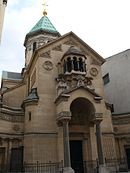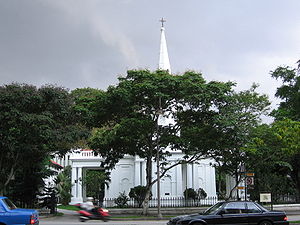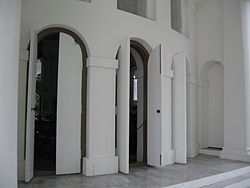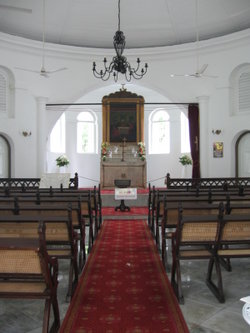- Armenian Church, Singapore
-
This article is about the Armenian Church in Singapore. For the general article about the Armenian Apostolic Church, see Armenian Apostolic Church.For other uses, see St. Gregory the Illuminator's Church (disambiguation).
Coordinates: 1°17′35″N 103°50′57.5″E / 1.29306°N 103.849306°E
The church's entrance features heavy two-leaf timber doors framed by moulded semi-circular pediments. The parsonage, a two-storey bungalow, on the church grounds was built in 1905 by Nanajan Sarkies in memory of her late husband, John Shanazar Sarkies.
The parsonage, a two-storey bungalow, on the church grounds was built in 1905 by Nanajan Sarkies in memory of her late husband, John Shanazar Sarkies.
The Armenian Church (full name: Armenian Church of Saint Gregory the Illuminator; Chinese: 亚米尼亚教堂; pinyin: Yàmǐníyà Jiàotáng; Armenian: Սուրբ Գրիգոր Լուսաւորիչի Եկեղեցի – Surb Grigor Lusavorichi Yekeghetsi) is the oldest Christian church in Singapore, located at Hill Street in the Museum Planning Area, within the Central Area, Singapore's central business district.
Contents
History
George Drumgoole Coleman, overseer of Convicts and Superintendent of Public Works, was the architect of many of Singapore's finest historical buildings. The Armenian Church, arguably his masterpiece, is perhaps the finest landmark in the early architectural development of the nation.
The government granted the land on which the church stands to the Armenian community in 1834. By 1835, the building was completed. Consecrated by Reverend Catchick Johannes in 1836 and dedicated to St Gregory the Illuminator, the first Patriarch of the Church in Armenia, it was the second church to be built in Singapore.
Over half the construction cost of 5,000 Spanish dollars was donated by the Armenian community in Singapore, with the rest coming from Armenians in Java and India, and a small portion from European and Chinese merchants in Singapore. Considering that the Armenian community was tiny — the 1824 census counted only 16 members — its contribution to the Armenian Church was huge in proportion, a testament to the religious devotion of the Armenians. Even in 1821, two years after Sir Stamford Raffles' landing, the community held religious services and, in 1827, after funds had been collected, the first priest, the Reverend Krikor Hovhannes (Gregory John), arrived.
Armenian Street is named after the church and its Chinese name is seng poh sin chu au (the back of Seng Poh's new building).
Armenian Church was gazetted as a national monument on 6 July 1973.
Architecture
The original, elegant and symmetrical design included neither tower nor spire. It featured an octagonal cone supporting a small bell turret with Ionic columns.
The existing Armenian Church, built in the British Neo-Classical style, is modelled after St Gregory's Church in Echmiadzin, the mother church in northern Armenia. It is possible that the client's brief made reference to this. The structure is circular, imposed on a square plan, with projecting square porticos using Roman Doric orders. The chancel-cum-altar is semi-circular. The Palladian-style design was possibly inspired by James Gibbs' first circular plan for St Martin-in-the-Fields which he published in his Book of Architecture (London, 1728).
Nevertheless, with all the eclectic references, Coleman produced a design which is adapted to suit Singapore's tropical climate. For instance, the wide verandahs give essential shade and protect the timber-louvred windows on the ground floor from heavy downpours. The windows, in turn, diffuse the sunlight and induce cross ventilation. The pews, which would normally be entirely in wood, are backed with woven rattan, a much lighter and cooler material.
The spire, topped with a ball and cross, sits on the octagonal tower, and is the second to replace the original bell turret by Coleman, which proved to be structurally unsound and was demolished. It was replaced by a square tower, using Doric pilasters, in 1846, followed by the present spire in 1853. An English architect called Maddock had the pitched roof replaced by the present one, the bell turret removed and, to support the existing tower and spire, added the east portico around the original chancel. Probably, at the same time, the main entrance on the west portico was widened.
On the north, south and west fronts of the church are Tuscan Doric porticos capped with triangular pediments. The east front, where the main entrance lies, bears an elegant bowed apse with a pediment into which the date "1835" is carved to commemorate the year the church's foundation was laid. The north, south and west porticos were designed such that horse carriages could pull into the porches, right up to the doors of the church. The porches were designed to be on level with the base of the carriages so that ladies could step into the church without soiling their dresses on the ground below.
Although the interior is curcular, said to resemble the famous round Holy Sepulchre in Cambridge, England, it is actually based on a square cross, symbolic of the Cross of Christ. Facing the main entrance is the grand altar, prominently raised above the height of the pews.
On the church grounds are the parsonage and the Memorial Garden to Armenians. The parsonage, a two-storey bungalow, was built in 1905 by Nanajan Sarkies in memory of her late husband, John Shanazar Sarkies. Amongst the Armenians in Singapore, the Sarkies family was probably the most notable, in particular brothers Archak, Aviet and Tigran of Raffles Hotel fame. A number of tombstones of prominent Armenians, such as Agnes Joaquim who bred Singapore's national flower and Catchik Moses who founded the Straits Times newspaper lie here.
The Memorial Garden was never used as a burial ground. The tombstones that lie there were all transported from the Christian cemetery in Bukit Timah when it was exhumed in 1978.
Current use
The last Armenian parish priest left in the late 1930s, and with the dwindling Armenian population in Singapore, a successor was never appointed. Armenian and Eastern Orthodox services were held occasionally, particularly at Christmas and Easter, for a number of years. The only group of Orthodox to use the church on a regular basis are the Jacobite Syrian Church of India and Coptic Orthodox community of Saint Mark. The Jacobite Syrain Church holds services in the evenings on First Sunday and in the mornings on other Sundays. The Coptic Orthodox church holds Vespers, Matins and Divine Liturgy on the first weekend of every month.
In 2006, the church was used as an exhibition site for the Singapore Biennale. "Everything Is Contestable" by Indian artist Ashok Sukumaran was a site-specific intervention that introduced two switches which would be able to control the lights of the church, one at the gates of the church (working only intermittently) and one across the street.
See also
References
- National Heritage Board (2002), Singapore's 100 Historic Places, Archipelago Press, ISBN 981-4068-23-3
- Norman Edwards, Peter Keys (1996), Singapore - A Guide to Buildings, Streets, Places, Times Books International, ISBN 9971-65-231-5
Nadia Wright 'Respected Citizens: the history of Armenians in Singapore and Malaysia' Amassia Publishing 2003, Chapter 9.
External links
- The History of Armenians in Singapore and Malaysia
- Uniquely Singapore article
- 360 degree VR image of the Armenian Church, Singapore
- Armenian Church of St. Gregory the Illuminator Singapore
Protestantism Bethany Independent-Presbyterian Church Singapore · Church of the Province of South East Asia in Singapore · Church of Our Saviour, Singapore · City Harvest Church · Cornerstone Community Church · Elim Church Singapore · Evangel Family Church · Faith Community Baptist Church · Grace Assembly of God · Heart of God Church · Grace Church · Lighthouse Evangelism · Methodist Church in Singapore · New Creation Church · Singapore Baptist Convention · True Jesus Church in Singapore ·
Roman Catholicism Orthodox (Eastern & Oriental) Singapore Armenian Church ·
 Contemporary Armenian Churches and Seminaries
Contemporary Armenian Churches and Seminaries 
Armenia Etchmiadzin Cathedral · Gevorkian Theological Seminary · Gayane · Geghard · Goshavank · Hovhannavank · Hripsime · Karmravor · Kecharis · Khor Virap · Oshakan · Saghmosavank · Sanahin · Shoghakat · Tegher · Vaskenian Theological Academy · Yeghvart Yerevan: Holy Trinity · Katoghike · Saint Poghos-Petros Church · Saint Gregory the Illuminator Cathedral · Saint John the Baptist · Saint Sargis (Kentron) · Saint Sarkis (Nor Nork) · Surb Zoravor Astvatsatsin Church 
Nagorno Karabakh Republic (Artsakh) France Île-de-France: St. Jean-Baptiste Armenian Apostolic Cathedral, Paris · St. Gregory the Illuminator Church, Chaville · Holy Mother of God Armenian Apostolic Church, Issy-les-Moulineaux · St. Paul and St. Peter Church, Alfortville · Holy Cross of Varak Armenian Church, Arnouville-Lès-Gonesse · Holy Cross Armenian Catholic Cathedral, Paris · St. Gregory the Illuminator Armenian Catholic Church, Arnouville-Lès-Gonesse · Rhône-Alpes: St. Jack Armenian Apostolic Cathedral, Lyon · Holy Mother of God Armenian Apostolic Church, Décines · St. Gregory the Illuminator Church, St. Etienne · Saint Neshan Church, Charvieu-Chavagneux · Saint Sahak Church, Valence · St. Gregory the Illuminator Church, Valence · Armenian Apostolic Church, Grenoble · St. Nicolas Church, Romans · Armenian Apostolic Church, Vienne · Armenian Catholic Church, Lyon · Armenian Catholic Church, Valence · St. Nerses Armenian Catholic Church, Saint Chamond · Marseille and Southern France: St. Mesrob and St. Sahak Armenian Apostolic Cathedral, Marseille · Holy Mother of God Armenian Apostolic Church, Marseille · St. Garabed Church, Marseille · St. Thaddeus and St. Bartholomew Chruch, Marseille · St. Jack Church, Marseille · Holy Savior Armenian Apostolic Church, La Ciotat · Holy Mother of God Armenian Apostolic Church, Nice · St. John Armenian Church, Saint-Raphaë · St. Vartan Armenian Church, Avignon · St. Gregory the Illuminator Armenian Catholic Church, Marseille Turkey Aghtamar · Holy Apostles Church of Kars · Holy Apostles Monastery · Horomos · Ktuts · Monastery of the All-Saviour (Trebizond) · Mren · Narekavank · Saint Bartholomew Monastery · Saint Karapet Monastery · St. Marineh Church, Mush · Tekor Basilica · Varagavank Georgia Tbilisi: Cathedral of Saint Gevorg · Church of the Holy Seal · Church of the Red Gospel · Ejmiatsin · Holy Mother of God (Bethlehem) · Holy Mother of God (Mens) · Holy Mother of God (Norashen) · Saint George · Saint Gevorg of Mughni · Saint Karapet · Saint Minas · Saint Stephanos · Chugureti St. Astvatsatsin Lebanon Armenian Catholicosate of Cilicia · Armenian Catholic Patriarchate ·
Beirut: Armenian Church of the Holy Cross, Beirut · Holy Cross (St. Neshan) Church, Beirut Central District · St. Elie - St. Krikor Lousavoritch Cathedral, Beirut · Saint George Armenian Apostolic Church, Beirut · Saint Hagop Church, Beirut · Saint Sarkis Church, Beirut · Armenian Catholic Church of the Annunciation, Beirut · Armenian Catholic Church of the Annunciation , Beirut ·
Bourj Hammoud: The Church of the Forty Martyrs of Sebastia, Bourj Hammoud · St. Mesrob Church, Bourj Hammoud · Holy Mother of God Armenian Church, Bourj Hammoud · St. Saviour Armenian Catholic Church, Bourj Hammoud · St. Savior Armenian Catholic Church, Bourj Hammoud
Bikfaya: Armenian Apostolic Seminary at Bikfaya · Convent Of Mekhitarist Fathers, Bikfaya ·
Anjar: St. Paul Church, Anjar · Our Lady of the Rosary Armenian Catholic Church, Anjar ·
Others: Our Lady Convent Of Bzoummar · Holy Cross Church, Zalka · St. Rita Church, Mezher · Holy Pentecost Armenian Apostolic Church, Tripoli · Our Lady of Fatima Armenian Catholic Church, Zahle ·Syria Aleppo: Church of the Holy Mother of God · Cathedral of the forty martyrs of Sebastia · St. Hagop Church · St. Gregory the Illuminator Church · Holy Trinity Church · Holy Cross Church · Church of Our Lady of Annunciation · Cathedral of Our Mother of Reliefs · Damascus: St. Sarkis Armenian Church, Damascus · Our Lady of the Universe Armenian Catholic Church, Damascus · Latakia: St. Hripsime Church, Yacoubieh · St. Anna Church, Yacoubieh · Church of the Holy Mother of God, Kesab · Church of the Holy Mother of God, Latakia · Church of the Holy Mother of God, Karadouran · Armenian Church, Ekizoluk · St. Stephen Church,Aramo · St. George Church, Ghnemiyeh · Our Lady of the Assumption, Kesab · Deir ez-Zor: Armenian Genocide Memorial Church (Der Zor) · Ar-Raqqah: Church of the Holy Mother of God, Ar-Raqqah · Holy Cross Church, Abyad · Al-Hasakah: Church of the Holy Mother of God, Al-Malikiyah · Holy Cross Mother of God Church, Ra's al-'Ayn · Saint John the Baptist Church, Al-Hasakah · Saint Joseph Armenian Catholic Church, Al-Qamishli · Holy Family Church, Al-Hasakah Azerbaijan Iran Saint Sargis · Saint Thaddeus · Vank Cathedral Israel Cathedral of St. James · Church of the Archangels · St. Toros Church · Chapel of Saint Helena · Saint Nicholas Monastery United States Mother Cathedral of the Western Diocese, Burbank · Saint Mary's Armenian Church, Glendale · Saint Gregory the Illuminator Catholic Church, Glendale · St. Vartan Cathedral · Saint Sarkis of Dearborn Other countries Categories:- Churches in Singapore
- Armenian Apostolic churches
- Armenian Churches
- Visitor attractions in Singapore
- Landmarks in Singapore
- National Monuments of Singapore
- Buildings and structures completed in 1835
- 19th-century church buildings
- Museum Planning Area
Wikimedia Foundation. 2010.








